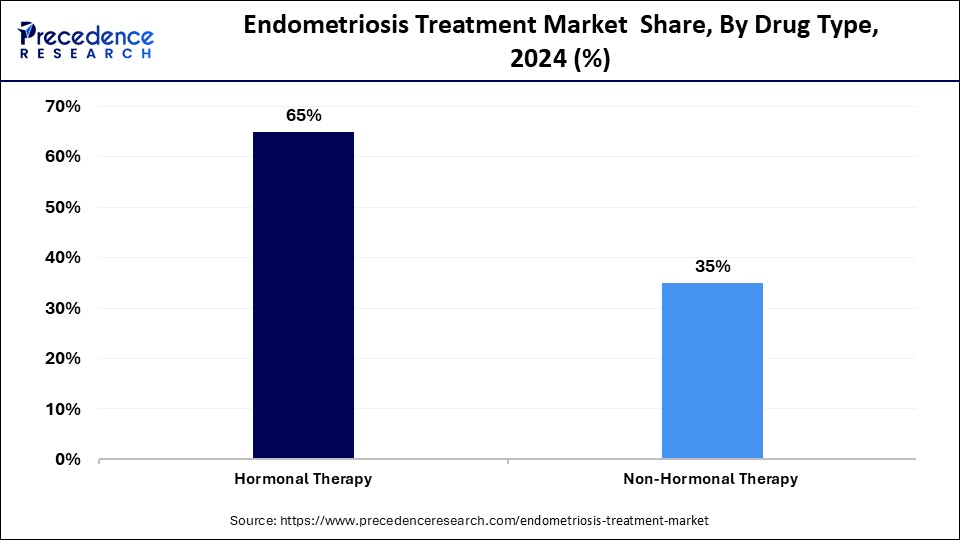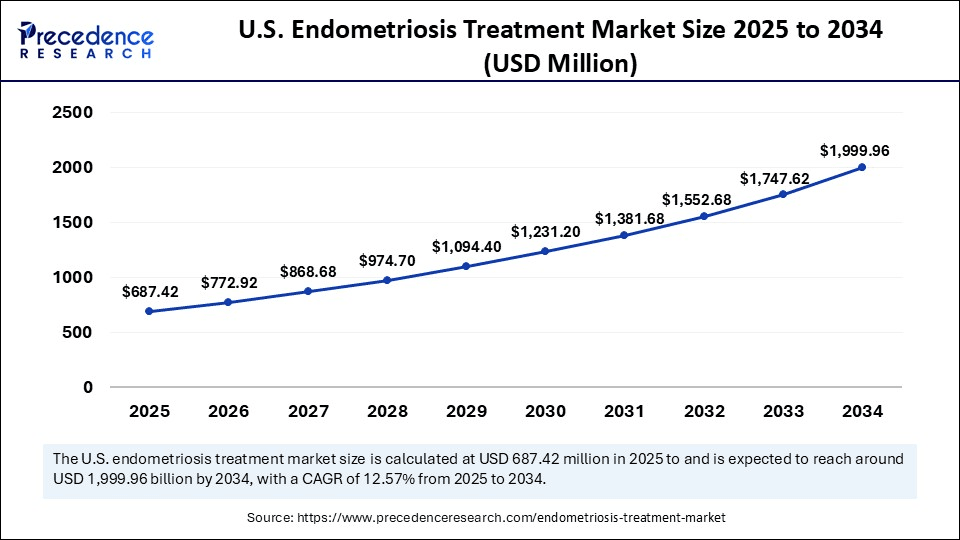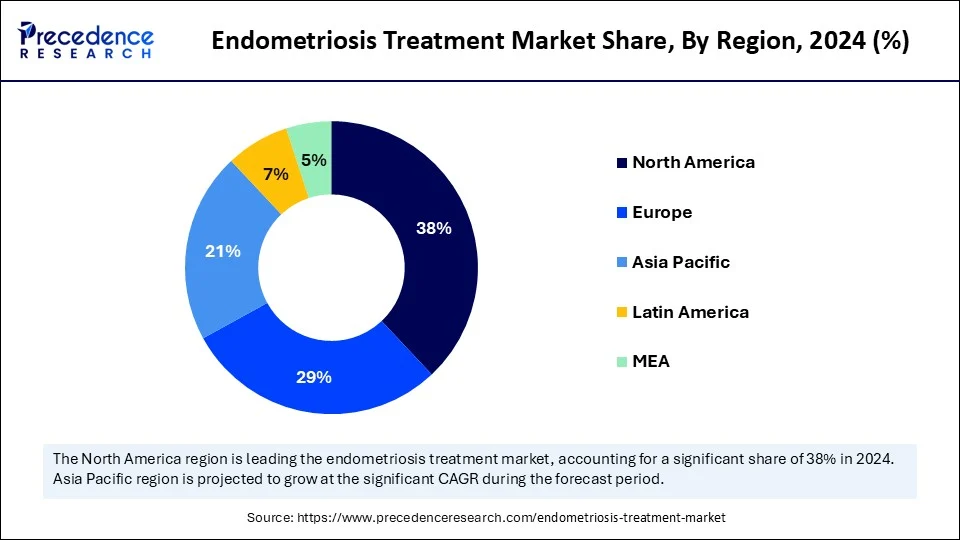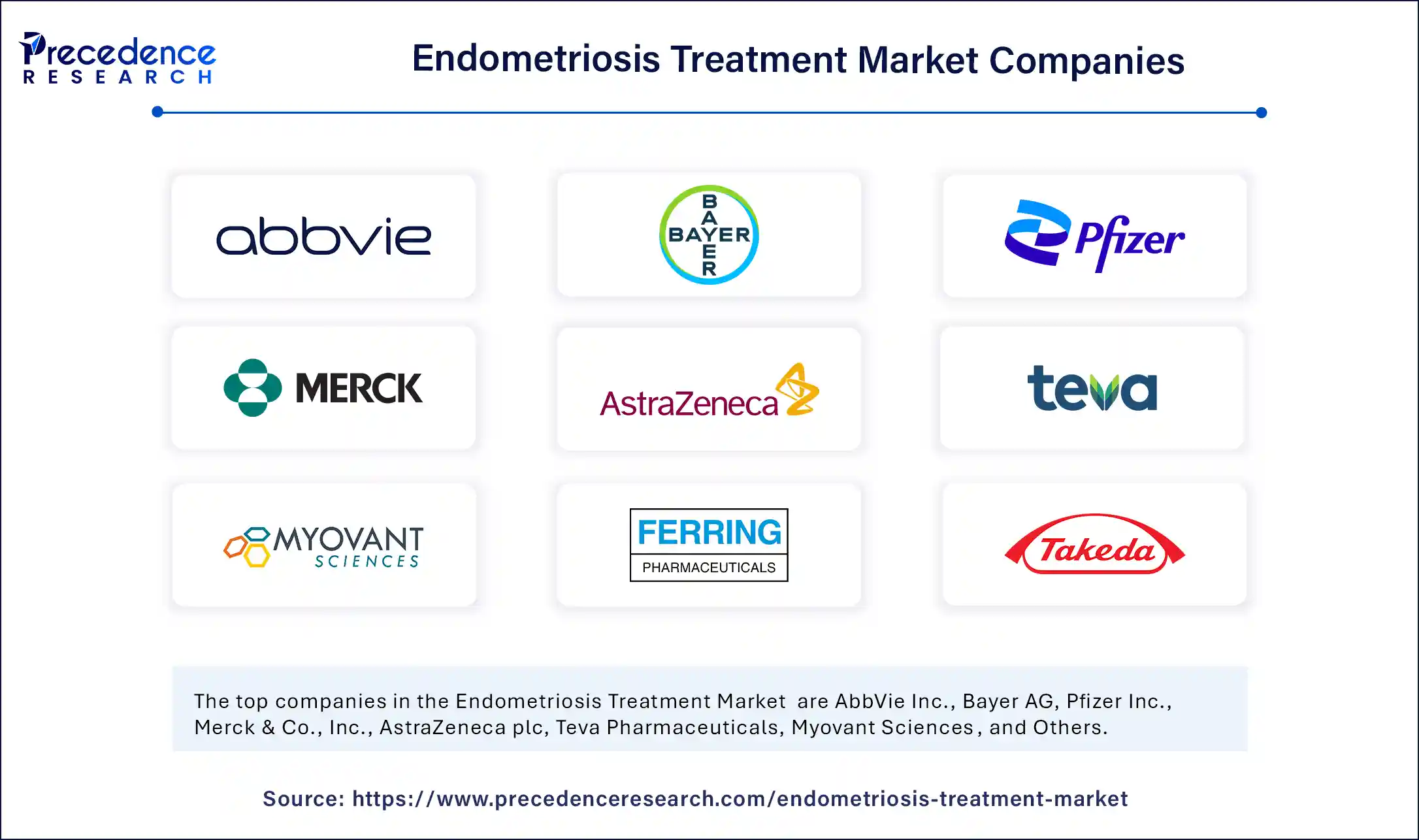What is the Endometriosis Treatment Market Size?
The global endometriosis treatment market size is accounted at USD 2.01 billion in 2025 and is predicted to increase from USD 2.26 billion in 2026 to approximately USD 5.74 billion by 2034, expanding at a CAGR of 12.35% from 2025 to 2034. Ongoing research studies and clinical trials are leading the development of novel and effective treatment options, driving the global endometriosis treatment market. The rising government funding and policies in support of Women's Health are contributing to market growth.

Endometriosis Treatment MarketKey Takeaways
- North America dominated the global endometriosis treatment market with the largest market share of 38% in 2024.
- Asia Pacific is expected to grow at a significant CAGR from 2025 to 2034.
- By drug type, the hormonal therapy segment contributed the biggest market share of 65% in 2024 and is expected to grow at the fastest rate over the forecast period.
- By surgery type, the conservative surgery segment held the major market share of 60% in 2024.
- By surgery type, the definitive surgery segment will grow at the highest CAGR between 2025 and 2034.
- By route of administration, the oral segment captured the largest market share of 55% in 2024.
- By route of administration, the injectables segment will expand at a significant CAGR between 2025 and 2034.
- By distribution channel, the hospital pharmacies segment held the highest market share of 45% in 2024.
- By distribution channel, the online pharmacies segment is expected to grow at the fastest CAGR between 2025 and 2034.
- By end-user, the hospitals and clinics segment accounted for biggest market share 50% in 2024.
- By end-user, the specialty centers segment is expected to expand at a significant compound annual growth rate (CAGR) between 2025 and 2034.
Market Overview
The endometriosis treatment market encompasses pharmaceutical, surgical, and other therapeutic solutions designed for the management or treatment of endometriosis, a chronic gynecological disorder characterized by tissue from the lining of the uterus growing outside the uterus. The market includes drugs like hormonal & non-hormonal, surgical interventions like laparoscopy and hysterectomy, and support therapies like pain management & fertility treatments. The growing awareness of endometriosis, pregnancy delays, and advancements in diagnostics and personalized medicine are the major factors supporting market growth. The GnRH analogs and hormonal therapies are widely used drug classes in endometriosis treatments. Hospital and retail pharmacies are contributing a major share of the endometriosis treatment market.
The rising prevalence of endometriosis in women is driving the need for innovative and effective treatment solutions. According to the World Health Organization (WHO), roughly 10% of women and girls of reproductive age, approximately 190 million people, are experiencing chronic pain because of endometriosis. Moreover, the rising awareness about the conditions, growing advancements in diagnostic techniques, continuous research, and regulatory approvals for innovative therapies are fueling the global market.
- In May 2025, the NHS in England approved Linzagolix, a new daily pill treating endometriosis. The pill has an estimated effect on 1.5 million women in the UK and will soon be available for above 1,000 women to manage the symptoms of the endometriosis condition.
How is AI Impacting Endometriosis Treatments?
Artificial Intelligence is a transformative tool in endometriosis treatments, playing a significant role in enhancing diagnosis by analyzing medical images, patient data, and symptoms. Medical images, pathology, and genomics are the major areas where AI is playing a crucial role in expanding the analysis of scans, genomes, and samples. Sophisticated data, samples, images, and genomics are required for the diagnosis and treatment of endometriosis. By analyzing individual data, history, and genetic profiles, AI enables the development of personalized treatments. AI is not only improving areas of diagnosis but also helping researchers to streamline research studies and clinical trials. AI further contributes to enhancing patient engagement by providing personalized support and education.
How Smart Algorithms Transform Endometriosis Care
Recent innovations are accelerating detection and treatment. Teams and start-ups in Europe are training deep-learning models on ultrasound and MRI datasets to detect lesions sooner, and studies show high sensitivity and promising public auto-segmentation datasets. While the ETH spin-off Scanvio and the FAU EndoKI project are developing AI assistants, including one designed to flag suspicious pelvic ultrasound features, and a second to 'fuse' multimodal imaging into 3D patient models. Clinical trials, explainable-AI methods, and multi-center imaging initiaves aim to reduce the long delays to diagnosis allowing non-specialists to more readily detect endometriosis, leading to faster referrals, personalized treatment planning, and improved outcomes for patients.
What are the Key Trends in the Endometriosis Treatment Market?
- Rising Awareness: The growing awareness about endometriosis and its impact on human health is driving demand for enhanced diagnostic and effective treatment plans.
- Developments of Innovative Therapies: The pharmaceutical companies are focusing on the development of novel treatment options, like targeted medication, immunomodulators, and non-hormonal treatments.
- Advancements in Diagnostic Techniques: The active advancements in diagnostic equipment and biomarker-based tests, aiming to enhance early detection, contribute to the market growth.
- Research and Developments: The rising number of research and clinical trials is enabling the development of new and effective treatment solutions for endometriosis.
- Government Initiatives: Governments worldwide have implemented several policies and funding for women's health, enabling access to innovative and effective endometriosis treatment options.
Market Scope
| Report Coverage | Details |
| Market Size by 2034 | USD 5.74 Billion |
| Market Size in 2026 | USD 2.26 Billion |
| Market Size in 2025 | USD 2.01 Billion |
| Market Growth Rate from 2025 to 2034 | CAGR of 12.35% |
| Dominating Region | North America |
| Fastest Growing Region | Asia Pacific |
| Base Year | 2024 |
| Forecast Period | 2025 to 2034 |
| Segments Covered | Drug Type, Route of Administration, Surgery Type, End-User, and Region |
| Regions Covered | North America, Europe, Asia-Pacific, Latin America, and Middle East & Africa |
Market Dynamics
Drivers
Awareness and Early Diagnosis
The rising awareness about the endometriosis condition, driven by increased prevalence and government initiatives in enhancing women's health, is the major factor driving the growth of the endometriosis market. The awareness about the endometriosis condition and its impact on women is rising among women and healthcare professionals, driving demand for early diagnosis. The increased awareness has led to a higher demand for early detection, and effective therapies contribute to enhancing research and development for innovative treatment options. Government initiatives in promoting women's health, along with increased funding for research, are further driving innovations and growth in demand, as well as the development of effective endometriosis treatment solutions.
Restraint
Lack of Definitive Cure
The recent treatment options for endometriosis are mainly focused on symptom management and disease progression. The effectiveness of treatment varies in individual patients, making it challenging the develop standardized treatments. The need for ongoing treatments and effective symptom management is increasing healthcare costs. Additionally, the lack of a definitive cure leads to patient dissatisfaction and frustration, making it difficult to maintain quality of life.
Opportunity
Growing Demand for Minimally Invasive Surgical Procedures
The rising demand for minimally invasive surgical procedures, such as laparoscopy and robotic-assisted surgery, creates immense opportunities in the endometriosis treatment market. The increased prevalence of endometriosis among women and girls has led to less painful and scarring surgical procedures. Minimally invasive procedures help reduce recovery time, minimize blood loss, enhance visualization, and result in fewer postoperative complications. Minimally invasive surgical techniques and technologies are enabling enhanced accuracy in procedures like the removal of endometrial lesions, thereby improving the results. The rising medical health insurance coverage is further enabling accessibility and affordability of minimally invasive surgical procedures for endometriosis.
Segmental Insight
Drug Type Insights
Which Drug Type Segment is Leading the Endometriosis Treatment Market?
The hormonal therapy segment led the market with a major revenue share and is expected to grow at the fastest rate during the forecast period, driven by the widespread use of hormonal therapy for effective management of symptoms, including pain and inflammation. Hormonal therapies like GnRH agonists, oral contraceptives, and progestins are majorly used therapies for the management of pain, heavy menstrual bleeding, and dysmenorrhea.The well-established hormonal therapies in clinical practice enable large availability and accessibility of the drug. Ongoing advancements in the formulations of hormonal treatments, such as GnRH antagonists, aim to reduce side effects and improve the effectiveness and accuracy of these medications.

Surgery Type Insights
Why Did the Conservative Surgery Segment Dominate the Market in 2024?
The conservative surgery segment dominated the endometriosis treatment market with a 60% share in 2024. This is mainly due to its increased usage, which is facilitated by its ability to respond to medical management. Women seeking to preserve fertility contribute high demand for conservative surgeries. The surgery was performed to remove endometriosis lesions, aligning with preserving the uterus. Alternative conservation surgery, like laparoscopy, is widely used for patients who do not respond to pain management medications or hormonal therapies. The high success rate of this surgery makes it a preferred option among patients.
The definitive surgery segment is the second-largest segment and is expected to grow at a significant rate in the upcoming period due to the increasing use of surgeries such as hysterectomy and laparoscopic excision for patients with severe symptoms or who do not respond to other treatment options. The laparoscopic excision removes endometrial tissues by utilizing specialized instruments. The rising demand for personalized and non-invasive treatments is contributing to the segment's growth.
Route of Administration Insights
How Does the Oral Segment Dominate the Endometriosis Treatment Market in 2024?
The oral segment dominated the market, holding a 55% share in 2024. This is primarily due to patients' increasing preference for convenient and effective medications. Oral medicines provide effective symptom management. The wide accessibility of oral medications and ease of consumption fuel the demand for oral medications for endometriosis. Oral medications are cost-effective compared to other administrative medications, making them prior in a wide range of patients. The oral medications are mostly used as first-line treatment for pain relief, to reduce menstrual flow, and COCs (Combined Oral Contraceptives) suppress ovulation.
The injectables segment is expected to grow at the fastest rate over the projection period, driven by its role in providing long-acting and quick symptom management. Injectable treatments are widely used for the targeted delivery of medications. Healthcare providers prefer injectable medications like GnRH agonists and progestins to gain sustained treatment effects and reduce the need for daily medication or oral medication.
Distribution Channel Insights
What Made Hospital Pharmacies the Dominant Segment in the Endometriosis Treatment Market in 2024?
The hospital pharmacies segment led the market by capturing a 45% share in 2024. This is mainly due to the wide availability and accessibility of effective endometriosis treatment solutions in hospital pharmacies. With the increased prevalence of endometriosis, hospitalization rates have increased. This prompted the need for prescription drugs to manage the condition, which are mostly available in hospital pharmacies. Inpatient and outpatient services provided by hospital pharmacists are contributing to the growth of the segment. Hospital pharmacists provide guidance with medications, enhancing patient outcomes.
The online pharmacies segment is expected to expand at the highest CAGR in the upcoming period, driven by the rising patient preference for convince, affordability, and easy access. Online pharmacies provide a wide range of treatment options, increasing purchase volume. Online platforms are enhancing accessibility to a range of treatments, making it easy for people in remote or underserve areas to obtain treatments. Online pharmacies also offer free consultations with doctors, reducing hospital visits. Moreover, these pharmacies provide easy doorstep delivery, leading to repeat purchases.
End-User Insights
Which End-user Dominated the Endometriosis Treatment Market in 2024?
The hospitals & clinics segment dominated the market with a 50% share in 2024. This is mainly due to their offering of comprehensive care. Hospitals and clinics offer patient-centric treatments, specialized care, and multidisciplinary experts. A multidisciplinary team of hospitals and clinics provides personalized treatment plans, ensuring effective management of endometriosis symptoms in complex cases. The initial availability of specialization and access to more effective treatment plans are contributing to the segment's growth. Additionally, the increasing government funding for hospitals and health insurance coverage is meeting patients' preferences for hospitals and clinics. These settings are considered a primary point of care, contributing to segmental growth.
The specialty centers segment is expected to grow at the fastest rate during the forecast period due to increasing patient preference for specialized care plans to treat endometriosis. Specialty centers offer specialized expertise, comprehensive care, and wide access to advanced diagnostic technologies. Specialty centers are comprehensive providers of multidisciplinary teams, ensuring effective and improved diagnosis and enhancing patient outcomes.
Regional Insights
U.S. Endometriosis Treatment Market Size and Growth 2025 to 2034
The U.S. endometriosis treatment market size is exhibited at USD 687.42 million in 2025 and is projected to be worth around USD 1,999.96 million by 2034, growing at a CAGR of 12.57% from 2025 to 2034.

What Factors Contribute to North America's Dominance in the Endometriosis Treatment Market?
North America dominated the global endometriosis treatment market, capturing the largest revenue share in 2024. This is mainly due to the high prevalence of endometriosis, increased awareness, and well-developed healthcare infrastructure. The region is home to some of the leading research institutions, leading to the development of innovative treatments. There is a high demand for novel, effective treatment options to reduce the burden of endometriosis. Greater awareness of conditions has led to an increased number of patients undergoing diagnosis, prompting the urgent need for treatment.
The U.S. is a major player, contributing significantly to the growth of the market within North America. This is mainly due to its strong research, regulatory approvals for new therapies, and technological advancements. The rising prevalence of endometriosis in the U.S. is driving the need for effective diagnostic tools and treatment options. Strict regulations and approvals for innovative treatments are also fueling market growth.
The United States polyurea market is being driven by infrastructure upgrades, industrial coatings, and an increase in demand from the construction and automotive industries. The market penetration will be bolstered by the high rate of adoption in protective coatings, rapid-curing applications, and waterproofing applications. Technological innovation from the development of spray-applied polyurea and the emphasis on chemical-resistant, durable insulation will advance growth in the market, which is why the United States is an innovative leader in polyurea applications.
- In May 2025, the National Institutes of Health and the Endometriosis Foundation of America has reserved funds for the research at MSU researchers, who are exploring ways the develop new non-hormonal therapies for endometriosis patients.
(Source: https://humanmedicine.msu.edu) - In 2024, a clinical trial at the University of Oxford unveiled a study that mentioned ways to radically enhance the diagnosis of endometriosis for women across the world. The study includes the use of a specific imaging technique by using a 99mTc-marciclatide marker. Here are 25 participants in research with endometriosis who undergo the scan before surgery.
(Source: https://blog.mdpi.com)

Asia Pacific Endometriosis Treatment Market Trends
Asia Pacific is the fastest-growing region in the global market, driven by rising prevalence, increased awareness, advancements in healthcare infrastructure, and government initiatives. The large population in Asia contributes to a significant patient pool for endometriosis. Government initiatives, investments in healthcare, and increased healthcare spending are improving access to and affordability of endometriosis treatments. Government campaigns to raise awareness of women's health are major contributors to regional market growth.
- In May 2025, at ASPIRE 2025, in Singapore, the Fertility Experts unveiled the New Gold standard for Endometriosis care and fertility preservation, to influence policy and enhance results for millions of women and girls across the Asia Pacific region.(Source: https://biopharmaapac.com)
China leads the regional market due to its large population, health disease burden, and favorable government policies supporting women's health and access to healthcare. Both local and international pharmaceutical companies in China are increasing investments in developing new endometriosis therapies. Hormone therapy is the most common treatment in Chinese healthcare.
China's polyurea market is experiencing exponential growth in the face of rapid construction, industrial infrastructure, and growing automotive production. The capacity of polyurea will grow through the increased use in market segments with protective coatings, waterproofing, or rapid-curing capabilities. Investment in, and increased capacity of advanced manufacturing methods, combined with the growing awareness of durable, corrosion-resistant, construction materials, is advancing the market position of China as a high-growth market for polyurea solutions.
India is a significant player, driven by increasing awareness about endometriosis and improved healthcare infrastructure. The growing prevalence of endometriosis in the country supports market expansion. Government initiatives, such as funding for hospital costs and awareness campaigns about early diagnosis, are boosting the market. The popularity of multidisciplinary care centers for comprehensive treatments is increasing access to effective endometriosis treatments in India.
How Is Europe Leading the Way Endometriosis Treatment Market?
Europe is becoming an attractive growth region for endometriosis surgical management, primarily due to increasing rates of diagnosis and the expansion of access to minimally invasive gynecologic procedures. Research institutions throughout Europe are driving progress in hormonal therapy and personalized care pathways for women. Initiatives from women's health organizations to raise awareness are decreasing diagnostic delays, along with direct government reimbursement provisions for advanced laparoscopic treatment.
Germany is at the forefront of endometriosis surgical treatment progress in Europe. The healthcare system provides low barriers for women to access care through the availability of specialists, early intervention, and multidisciplinary care. Academic medical centers are conducting large-scale clinical trials on next-generation hormonal therapies and alternatives to opioids for pain management. Awareness campaigns supported by the government are increasing the frequency of diagnosis, while patient advocacy groups promote timely consultations.
Europe Endometriosis Treatment Market Trends
Europe is considered to be a significantly growing area. This is mainly due to its focus on providing effective endometriosis treatment solutions, supported by strong research, educational institutions, and robust healthcare infrastructure. Collaborative efforts between public and private entities are expanding treatment options. Fertility-sparing procedures are well-developed and widely used in regional healthcare. Ongoing digital health integration is improving diagnosis and treatment for diseases like endometriosis.
Germany is a major player in the market, with growth driven by rising prevalence of condition, increased awareness, technological advancements, and supportive government initiatives. Germany has a strong healthcare infrastructure, actively promoting innovations in drug research and minimally invasive surgical procedures. Major players like Bayer AG, AbbVie, Pfizer, Takeda, and AstraZeneca are advancing oral treatments for endometriosis symptoms.
Is MEA Evolving Into a Significant Competitor in Endometriosis Treatment?
As access to health services improves and diagnostic awareness increases, the Middle East & Africa region is emerging in the endometriosis treatment space. Leading hospitals in the Gulf Cooperation Council (GCC) region are adopting the next wave of imaging and artificial intelligence (AI)-enabled diagnostics capabilities, as well as minimally invasive laparoscopic techniques, which streamline recovery paths and increase precision. In Africa, educational collaborations with international health and education organizations will broaden consultant training and improve referral pathways. As MEA invests in fertility clinics, uses telehealth to help monitor symptoms, and continues to support women's health initiatives, patients may adopt newer treatment options in diagnostic and hormonal therapies.
UAE Market Trends
The United Arab Emirates (UAE) leads in the level of adoption of advanced women's health centers, robotic-assisted laparoscopic procedures, and early-diagnosis standards. Its high healthcare spending, digital screening initiatives, and research collaboration with its local population demonstrate the global health foundation for new hormonal biomarker therapy and diagnostic technology adoption, establishing it as one of the leading treatment hubs in MEA.
Endometriosis Treatment Market Companies

- AbbVie Inc.
- Bayer AG
- Pfizer Inc.
- Merck & Co., Inc.
- AstraZeneca plc
- Teva Pharmaceuticals
- Myovant Sciences
- Ferring Pharmaceuticals
- Takeda Pharmaceutical Company Limited
- Mayne Pharma Group Limited
Recent Developments
- In March 2025, the EDAP's Focal One Robotics HIFU System got CE Mark certification for deep-infiltrating endometriosis treatments. The EDAP notified body, GMED, guaranteed this designation.
(Source: https://www.stockinsights.ai)
- In March 2025, Heranova Lifesciences Inc. announced the completion of Laboratory Development Test (LDT) validation for the company's groundbreaking, non-invasive diagnostic test, HerResolve. The diagnostic test has been developed to transform the management of endometriosis and will be launched at selected clinical centers in the US.
(Source: https://fox59.com)
- In October 2024, Lisata Therapeutics, Inc. entered into a sponsored research agreement with the University of Cincinnati to investigate Lisata's novel cyclic peptide product candidate, certepetide, in combination with bevacizumab (a VEGF inhibitor) in a preclinical animal model for the treatment of endometriosis. Bevacizumab has previously demonstrated efficacy in treating endometriosis.
(Source: https://ir.lisata.com)
Segments Covered in the Report
By Drug Type
- Hormonal Therapy
- Gonadotropin-Releasing Hormone (GnRH) Agonists
- Oral Contraceptives
- Progestins
- Danazol
- Non-Hormonal Therapy
- NSAIDs
- Analgesics
By Route of Administration
- Oral
- Injectables
- Nasal
- Others (e.g., implants, transdermal patches)
By Surgery Type
- Conservative Surgery
- Laparoscopy
- Laparotomy
- Definitive Surgery
- Hysterectomy with/without oophorectomy
By Distribution Channel
- Hospital Pharmacies
- Retail Pharmacies
- Online Pharmacies
By End-User
- Hospitals & Clinics
- Homecare
- Specialty Centers
- Others
By Region
- North America
- Europe
- Asia-Pacific
- Latin America
- Middle East & Africa
For inquiries regarding discounts, bulk purchases, or customization requests, please contact us at sales@precedenceresearch.com
Frequently Asked Questions
Ask For Sample
No cookie-cutter, only authentic analysis – take the 1st step to become a Precedence Research client




 sales@precedenceresearch.com
sales@precedenceresearch.com
 +1 804-441-9344
+1 804-441-9344